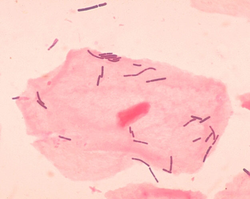| Lactobacillaceae | |
|---|---|
 | |
| Lactobacillus near a squamous epithelial cell | |
| Scientific classification | |
| Domain: | Bacteria |
| Kingdom: | Bacillati |
| Phylum: | Bacillota |
| Class: | Bacilli |
| Order: | Lactobacillales |
| Family: | Lactobacillaceae Winslow et al. 1917 (Approved Lists 1980) |
| Type genus | |
| Lactobacillus Beijerinck 1901 (Approved Lists 1980) | |
| Synonyms [1] | |
| |
The Lactobacillaceae are a family of lactic acid bacteria. [2] [3] It is the only family in the lactic acid bacteria which includes homofermentative and heterofermentative organisms; [4] in the Lactobacillaceae, the pathway used for hexose fermentation is a genus-specific trait. Lactobacillaceae include the homofermentative lactobacilli Lactobacillus , Holzapfelia , Amylolactobacillus, Bombilactobacillus , Companilactobacillus , Lapidilactobacillus , Agrilactobacillus , Schleiferilactobacillus, Loigolactobacillus, Lacticaseibacillus , Latilactobacillus , Dellaglioa, Liquorilactobacillus, Ligilactobacillus , and Lactiplantibacillus ; the heterofermentative lactobacilli Furfurilactobacillus, Paucilactobacillus, Limosilactobacillus , Fructilactobacillus , Acetilactobacillus, Apilactobacillus , Levilactobacillus , Secundilactobacillus, and Lentilactobacillus, which were previously classified in the genus Lactobacillus ; and the heterofermentative genera Convivina, Fructobacillus , Leuconostoc , Oenococcus , and Weissella which were previously classified in the Leuconostocaceae. [1]
Contents
The Lactobacillaceae are also the only family of the lactic acid bacteria which does not include pathogenic or opportunistic pathogenic organisms although some species, particularly Lacticaseibacillus rhamnosus and Weissella spp. can cause rare infections in critically ill patients. [5] [6]
With the exception of Lactococcus lactis, Streptococcus thermophilus and Tetragenococcus halophilus, most food fermenting lactic acid bacteria are now classified in the Lactobacillaceae. [1] [7] [8]
The grandfathered term lactobacilli refers to all bacteria classified in Lactobacillaceae prior to 2020, i.e. Lactobacillus sensu lato (pre-split), Pediococcus , and Sharpea . [1] Some authors use lactobacilli to refer to Lactobacillussensu lato only.